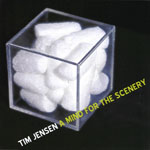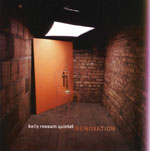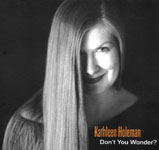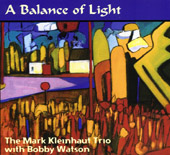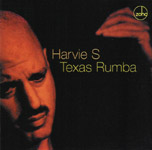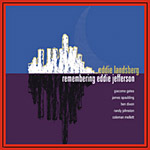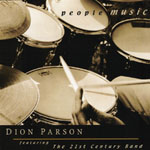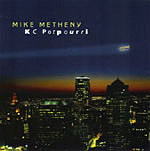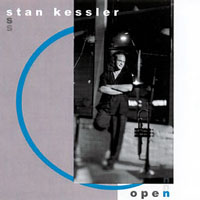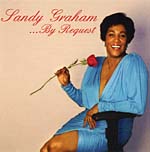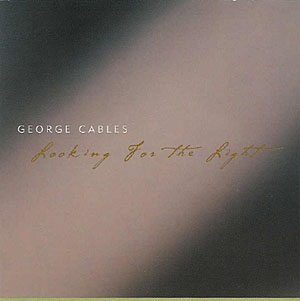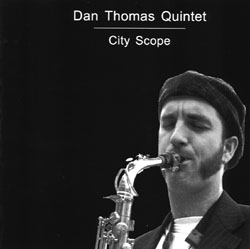|
|
||||||||||||||||||||||||||||||||||||||||||||||||||||||||||||||||||||||
|
Mark Kleinhaut Trio
with Bobby Watson Roy Haynes |
2004
Soul Eyes
Lafayette Music
By Tom Ineck
“Soul Eyes” is the definitive
recording for which longtime Joe Cartwright fans have been
waiting, a live trio project that exemplifies the Kansas City
pianist’s power and virtuosity in extended performances over a
range of material.
It is hard to imagine a
threesome more compatible than this one, as Cartwright is joined
by KC stalwarts Bob Bowman on bass and Todd Strait on drums.
Bowman’s fleet fingers, adventurous solo excursions and innate
sense of time are perfectly matched to Strait’s percussive
genius and sensitivity. Of course, it is Cartwright’s playing
that shines most brightly. Lush arpeggios, crisp, clean
single-note lines (at any tempo), soulful blues inflections and
stunning dynamics are just a few of his trademark qualities.
The Topeka Performing Arts
Center is the setting for three tunes, including Henry Mancini’s
classic “Dreamsville,” Cedar Walton’s keyboard workout “Ojos de
Rojo” and Bowman’s lively “Hebgan Happy Hour.” The Oak Bar of
the Fairmont Kansas City hotel is the scene for Pat Metheny’s
lovely “Always and Forever,” Gershwin’s “Love Walked In” and
Wayne Shorter’s “Fall,” and Kansas Public Radio captured the
trio’s rendition of the title track by Mal Waldron.
“Ojo de Rojo” is a case in
point, with Cartwright building the intensity before handing it
off to Bowman for an inspired solo. Strait then makes an
inventive solo statement on cymbals and toms. In like manner,
Bowman begins the 15-minute “Love Walked In” with a bluesy bass
blast, setting the stage for a lengthy and soulful exploration
by Cartwright, followed by briefer, but equally splendid bass
and drum solos.
The three ballad selections, “Dreamsville,”
“Always and Forever” and “Soul Eyes,” capture the trio in its
most sensitive interplay. Metheny’s gentle tune is especially
affecting in its honest, unabashed romanticism. Bowman and
Strait show admirable restraint on the title track, clearly a
showcase for Cartwright’s astonishing keyboard prowess.
Recorded at three different
venues last March, the sound throughout is well engineered and
amazingly unified. With just seven tracks totaling more than 70
minutes, “Soul Eyes” is a generous package perfect for the
gift-giving season. To order the CD, visit Joe Cartwright’s
website at
http://www.joe-cartwright.com/.
Armistice 1918
Bridge Boy Music
By Tom Ineck
Since his audacious performance
in Lincoln, Neb., in April 1998 with drummer Bill Stewart and
saxophonist Anton Denner as part of the trio
A Band in All Hope, pianist Bill
Carrothers of the Twin Cities has become one of our favorites
here at the Berman Music Foundation.
Carrothers’ latest and most
ambitious project, the two-disc, 30-track “Armistice 1918,”
seems to take up where his Civil War homage left off a few years
ago. But where “The Blues and the Greys” was a solo piano
recording, this is a larger, collaborative effort featuring the
haunting voice of Carrothers’ wife, Peg, and tasteful
instrumental contributions by Matt Turner, cello; Drew Gress,
bass; Stewart, drums, Jay Epstein, percussion and sound effects;
and Mark Henderson, bass clarinet.
Similarly to the Civil War
collection, the first half of “Armistice 1918” revisits familiar
tunes from the World War I period, re-imagining them in
unconventional—sometimes frightening—ways. Starting things off,
Bill and Peg Carrothers sing a wistful duet on “There’s a Long
Long Trail a Winding.” Then Bill improvises on a swinging trio
rendition of “Hello Ma Baby.” His solo stride piano on “Cuddle
Up a Little Closer” is light and breezy.
But “Armistice 1918” does not
glamorize or mythologize war. Rather, it dramatically contrasts
jingoism, popular myth and naïve sentimentality with the real
horrors of overwhelming death and destruction. Stewart seems to
be dropping “bombs” in the middle of “Let Me Call You
Sweetheart.” The sad irony is palpable in Peg Carrothers’
poignant reading of “Say Au Revoir,” as it is in the ominous
march tempo of “A Call to Arms (On Moonlight Bay).”
“I’m Always Chasing Rainbows,”
taken at a funereal tempo, is followed by a melancholic “And the
Band Played On” and a downright creepy “Christmas 1914 (Silent
Night),” its choral voices straining against discordant piano
and cello. ”There’s a Long Long Trail a Winding” returns in an
instrumental version, with a brief half-hearted vocalization of
“Over There,” the predominant World War I flag-waver. It is a
powerful statement of war’s futility and collective amnesia.
Saddest of all is “I’m Afraid to Come Home in the Dark,” with
its tolling bells and thunder claps, and the bittersweet finale,
“Till We Meet Again.”
The 2-CD package includes a
36-page booklet with period photos, poems and liner notes by
Carrothers and Thomas Compere-Morel, curator of the Historial de
la Grande Guerre, a WWI museum in Peronne, France, that
contributed financially to the project. Carrothers toured France
with this music Oct. 8-Nov. 15.
We also recommend Carrothers’
recordings “After Hours,” “Duets with Bill Stewart” and “Ye Who
Enter Here,” by A Band in All Hope. All of these and more are
available through Bridge Boy Music at
http://www.bridgeboymusic.com/.
Barcelona in 48 Hours
Strudelmedia
By Tom Ineck
Despite its rather ambiguous
title, “Barcelona in 48 Hours” reaches far beyond the city
limits of Spain’s principal seaport. Composer and
multi-instrumentalist Edward Ratliff has drawn inspiration from
the music of North Africa and Latin America, with occasional
flashes of Argentine tango, hip-hop rhythm and surf guitar.
The result, which was recorded,
mixed and mastered in Brooklyn and New York City, is a
fascinating journey through the wonderful world of movement and
music. Its thematic cohesion comes from the fact that it was
composed for a short film portrait of choreographer, teacher and
dancer David Zambrano. Made by photographer Anja Hitzenberger
and Ratliff, the film is made almost entirely from
black-and-white still photographs.
Having not yet seen the film, I
can only imagine that it is this evocative music that breathes
life into its otherwise static images. With the able assistance
of his band—the aptly named Rhapsodalia—Ratliff moves swiftly
through the paces, never allowing his colleagues or the listener
to become complacent.
In many cases, Ratliff relies on
his own virtuosity on cornet, trombone, accordion, celeste and
the Fender Rhodes piano to provide the broad palette of sounds.
Also essential to the mix are bandmates Michael Attias on alto
and baritone saxes, Sam Bardfeld on violin, John Hebert on bass
and Kevin Norton on drums. Additional support comes from Andy
Biskin, bass clarinet; Charlie Giordano, accordion; Chris Kelly,
programming, guitar and drums; Seido Salifoski, dumbek; and Doug
Wieselman, guitar.
When coupled with Ratliff’s
background in free improvisation and his offbeat esthetic
approach, this instrumental mélange gives a startlingly original
sound to “Barcelona in 48 Hours.” It begins with a full
five-piece band version of the central theme, “Barcelona,” which
is later restated on accordion and bass, later still by a
quarrelsome quartet and finally on solo accordion.
Between these thematic
variations, we hear the gentle waltz on solo celeste entitled
“Glass,” the eerie theme called “Horsey,” the Eastern-tinged
“Estacio de Franca” for accordion and dumbek and the sensuous
bolero “Night Dance,” highlighted by Ratliff’s muted cornet and
Wieselman’s sinuous guitar lines. “Sintuba” brings the
soundtrack to a rousing, rhythmic climax with a seven-piece
ensemble propelled by an irresistibly pulsating beat.
Liz Jeans, a freelance
choreographer, teacher and performing co-founder and artistic
director of Rite of Danse in Kansas City, Mo., also has given
this project her enthusiastic endorsement. Jeans’ own Latin
dance presentation, “Sierra Latina: A Latin Evening of Dance,”
was staged a year ago at the Kansas City Music Hall and was
reviewed in Jazz. For that story click
here.
The impressionistic
film for which this music was composed has been screened at film
and dance festivals in Italy, Spain, France, Austria, Germany,
Hungary and Venezuela, as well as on both U.S. coasts and in
Minneapolis. A live, multimedia version performed by Ratliff
debuted in February to sold-out houses and critical acclaim at
Dance Theater Workshop in New York City.
Here’s hoping that
“Barcelona in 48 Hours” will come soon to a theater near us.
Meanwhile, the CD is available at
www.strudel.net and at
www.amazon.com.
Opportunity Please Knock
Amplified Records
By Tom Ineck
Teraesa Vinson’s voice is not
huge, but what it lacks in sheer power and authority, she more
than makes up with a sure sense of dynamics, rhythmic nuance and
the kind of emotional connection that transcends mere technique.
Vinson’s impressive debut as a
recording artist, the double entendre “Opportunity Please
Knock,” is a coming-out that demands attention, not for
in-your-face audacity but rather for its subtle romanticism and
impeccable taste. She understands the power of understatement
and the allure of vulnerability. With very few missteps, she
also uses her superb instrumental accompaniment to get the
message across.
Her bandmates are truly a band,
with pianist Carlton Holmes, bassist Nicki Parrott and drummer
Dion Parson augmented by guitarist Tom Dempsey and tenor
saxophonist Ron Blake.
Take the opener. The
easy-swinging “What a Difference a Day Makes” begins with bass
and voice only, gradually adding guitar and drums and finally
tenor sax. “The Night Has a Thousand Eyes” picks up the tempo a
bit, but Vinson still reins herself in, comfortably riding the
crest of the piano wave created by Holmes. Sheila Jordan gets
credit for the unconventionally slow duo arrangement of “I’ve
Got the World on a String,” for voice and guitar only. “The Song
is You,” on the other hand, leaps along at a brisk tempo that
has the band at full steam, challenging Vinson’s vocal
pyrotechnics.
She recovers her poise for a
wonderful rendition of “Young and Foolish,” with some exemplary
tenor sax work by Blake. Likewise, the old favorites “A
Beautiful Friendship” and “The Way You Look Tonight” receive
stellar support. The latter is credited as another Jordan
arrangement for voice and guitar duo.
It is the more obscure tunes,
however, that seem the most effective. Artie Shaw’s “Moon Ray”
gets a suitably enchanting, heart-felt treatment highlighted by
Vinson’s sensuous vocal and Parrott’s walking bass line and
yearning solo. “While We’re Young,” one of those luminous Alec
Wilder melodies, shines with a swinging mid-tempo shuffle, and
Vinson’s endearing take on the lyric recalls the fancies of
fleeting youth.
The title track is a 1960s plea
for racial equality by Oscar Brown Jr., a tune covered in 1961
by Chris Connor, but seldom heard since. In Vinson’s hands, it
also serves as a wake-up call for her growing fan base and her
future employers.
“I Can’t Make You Love Me” is
Vinson’s greatest achievement here, a faithful rendition of the
Bonnie Raitt hit that stands on its own alongside covers by
Nancy Wilson, Kevin Mahogany and Freddy Cole. She caresses the
haunting lyrics with sparse backing by Parson using brushes and
mallets, Parrott on bass, Dempsey on guitar and Holmes on piano.
As it builds in intensity, Blake enters with a powerful but
restrained tenor solo, echoing Coltrane’s spiritual flights. A
group arrangement, it is a gem in the collaborative art of jazz.
When opportunity comes knocking,
Teraesa Vinson is ready to answer the call.
Group Therapy
OmniTone Records
By Tom Ineck
With “Group Therapy,” OmniTone
Records continues its exciting tightrope walk along the cutting
edge, the outer fringe of the mainstream, where deconstructed
standards and bold new compositions meet on common ground.
The Jim McNeely Tentet draws its
exceptional players from the ranks of the Vanguard and Carnegie
Hall jazz orchestras and includes Tony Kadleck, Greg Gisbert and
Scott Wendholt, trumpets; Tom Varner, French horn; Ed
Neumeister, trombone; Dick Oatts, Billy Drewes and Scott
Robinson, saxes; Cameron Brown, bass; and John Hollenbeck,
drums. Pianist McNeely wrote half of the eight tunes here, and
arranged all of them.
However, it is their
reinterpretation of the four “cover” tunes that give McNeely and
the Tentet their unique identity. Bud Powell’s “The Fruit” opens
the CD with a dramatic transformation of the original
composition. Like a deck of cards, the discrete themes are
shuffled, cut and dealt in innovative ways, and literally
everyone in the band gets a solo.
“Silent Night” is revelatory,
with the familiar theme only hinted as until late in the game.
Like a ghost of Christmas past, the haunting refrain slowly
emerges and is repeated and echoed in the brass section, with
especially poignant playing by Wendholt on muted trumpet.
Coltrane’s “Village Blues” gets
a more traditional treatment, with Neumeister delivering a
growling, plunger-muted tailgate solo. A repetitive brass motif,
a lovely brass chorale and the gorgeous alto saxophone playing
of Oatts elevate “Body and Soul” far above the mundane
treatments that this old warhorse usually receives.
“Lost” exhibits McNeely’s
composing and arranging genius in the counter-balancing of
written section parts and improvisation, especially during
Oatts’ inspired alto saxophone excursion. Like the therapeutic
session for which it is named, “Group Therapy” evolves from
individual “voices” to overlapping statements and even angry
outbursts that are eventually brought under control by the
soothing melody, representing the mediating therapist.
These extended pieces range from
six minutes (“Body and Soul”) to over 11 minutes for the title
track, creating plenty of “breathing” room in the arrangements
and plenty of solo space. But McNeely’s leadership never allows
the individual statements to become gratuitous blowing. It is a
marvelous accomplishment.
The Sound of a Dry Martini:
Remembering Paul Desmond
Origin Records
By Tom Ineck
We have mentioned before the
similarity between the alto sax sound of Brent Jensen and the
late Paul Desmond, composer of “Take Five” and long a member of
the Dave Brubeck Quartet.
It was especially evident
throughout Jensen’s weekend performances at the 2004 Topeka Jazz
Festival. All the elements are there—the phrasing, the fleet
fingering, and the tone. Perhaps it’s the tone more than
anything, a tone that Desmond himself described thusly: “I think
I had it in the back of my mind that I wanted to sound like a
dry martini.”
Known for his sly and witty
observations, Desmond had put his finger on it. It is a cool and
refreshing sound—light, bubbly, seemingly transparent, but
nonetheless intoxicating. Jensen has tapped into it on this
tribute CD, with a collection of tunes largely associated with
Desmond.
Rather than be compared with the
Brubeck group, he has assembled an excellent pianoless quartet
also featuring guitarist Jamie Findlay, bassist Zac Matthews and
drummer Dean Koba.
Desmond’s lovely “Wendy” starts
things off in a subtle swing tempo. “Tangerine” picks up the
pace slightly, and “Black Orpheus” introduces the Latin tinge
for which Desmond was so admired. The quartet gently swings the
blues on “Things Ain’t What They Used to Be.”
The obligatory “Take Five”
appears here, but Jensen takes a new approach while remaining
true to Desmond’s spirited, lilting style. Koba’s outstanding
percussion work also is prominently featured. Matthews’ walking
bass sets the mood for “Audrey,” co-written by Desmond and
Brubeck. Echoes of the Brubeck group return with Gerry
Mulligan’s “Line for Lyons.”
Over its eight minutes, “Body
and Soul” is painted on a broad canvas with a minimalist brush
and long, sinuous lines receding to the horizon, Jensen
exploring every nuance of the classic changes. “Out of Nowhere”
is taken at a lively tempo, but Jensen still maintains that
“cool” Desmond-style control. With its sweet nostalgic melody
and waltz tempo, “Alice in Wonderland” is the perfect closer to
this fine set.
Zach Brock and the Coffee
Achievers
Secret Fort Records
By Tom Ineck
Its surreal, whimsical multifold
dreamscape packaging is indicative of what lies within “Zach
Brock and the Coffee Achievers.” Indeed, this magical music is
at times surreal, at times whimsical, and at all times
wonderful.
We know Brock best for his dual
appearances in Lincoln, co-leading the Rob Scheps-Zach Brock
Quintet at P.O. Pears in January and October 2004. In that
context, his consummate skill as a violinist is indisputable,
though his leadership qualities are somewhat overshadowed by
saxophonist Scheps. On this 2002 release, he takes the helm with
the same confidence and imagination that he brings to his
playing.
Brock’s violin take center
stage, but it is only the foremost voice in a well-blended
ensemble that also includes the multiple keyboards of Sam Bar-sheshet,
the acoustic bass of Matt Wigton and the drums of Nori Tanaka.
All eight tunes herein are originals.
“Now I Know” is a caffeinated
opener that has the rhythm section percolating steadily under
Brock’s audacious fiddling. On “Common Ground” Bar-sheshet
injects edgy organ lines into the percussive mix. Wigton’s
“Turn” is a lovely, lilting waltz with a folk flavor that allows
nice contributions by all.
Bar-sheshet composed the brief,
atmospheric “Winter Transition,” with piano and violin stating
the theme and Tanaka on brushes. Brock plucks the violin on “The
Coffee Achiever,” creating the impression of a hot and heady
brew. “Solitary Candle” has violin, bass and piano weaving
tentative, fragile lines, while Tanaka deftly uses sticks and
mallets to create the perfect rhythmic setting. The leaping,
cascading mid-tempo “Low Sco” is a showcase for composer Bar-sheshet,
while Brock shows his stuff on the closer, “Mister Shaw,”
gradually building the intensity with help from the inspired
pianistics of Bar-sheshet.
Oddly, the bulk of “Zach Brock
and the Coffee Achievers” comes off as a much more relaxed
affair than a performance by the Scheps-Brock ensemble.
Sometimes, decaf is better.
Hope Is in the Air: The Music
of Elmo Hope
Origin Records
By Tom Ineck
Another drug casualty of the
post-bop era, pianist Elmo Hope died in 1967 at age 43,
seemingly putting an end to his potential influence on other
musicians. But he left behind a wealth of little-known
compositions that trumpeter-producer Don Sickler has now turned
to good purpose on this collaborative project.
With the help of Hope’s widow,
pianist Bertha Hope, Sickler compiled a collection of Hope’s
music, wrote lead sheets and turned it over to New Stories, the
excellent Seattle-based trio of pianist Marc Seales, bassist
Doug Miller and drummer John Bishop. The result is “Hope Is in
the Air,” a loving tribute to a too-long-forgotten piano legend.
Sickler and Bertha Hope also
make appearances, and alto saxophonist Bobby Porcelli plays a
prominent role on four of the 14 tracks. Finally, “This Sweet
Sorrow” is a haunting vocal rendering of Hope’s ballad “Barfly,”
sung by lyricist Roberta Gambarini and accompanied by pianist
Ronnie Mathews, bassist Peter Washington and drummer Kenny
Washington. In its varied settings, this sumptuous CD shows the
full scope of Hope’s original music.
To open the proceedings,
Porcelli deftly wends his way through the stop-and-go changes of
“Sims a Plenty,” a mid-tempo bopper. He also graces the frenetic
“One Second Please,” the gently swaying “Roll On” and the
hard-charging “Carving the Rock” (co-written by Sonny Rollins)
with his exuberant, imaginative playing.
The Latin-tinged “Dee-Dah,” the
lilting “Nieta” and the aptly spicy “Hot Sauce” alert listeners
to the similarity between Hope’s music and that of his
contemporaries Bud Powell and Thelonious Monk. Seales acquits
himself well in this challenging role, attacking the keyboard
with flair. The solid support of Miller and Bishop also is
evident on tunes like “A Kiss for My Love,” the gorgeous ballad
“Eyes So Beautiful as Yours” and the exotic “Stars Over
Marrakech.”
Bertha Hope and Sickler duet on
the ballads “Monique” and “Three Silver Quarters,” and Hope is
featured with Miller and Bishop on “Low Tide.” In her expressive
and sensitive playing, she shows a natural affinity for her
husband’s music.
Baker Sings
Chet
OA2 Records
By Butch
Berman
You can’t deny that perks still play a big roll in the entertainment biz.
The once revered 45 rpm record gave way to LPs and then CDs. Now
CDs are almost the calling/business card of today. The Web, home
CD burners and the whole music-buying scene is such a different
ballgame that the once traditional is now merely passé.
Thank God, still occasionally tucked away in this marketing maze of hopes
and dreams are some very talented people that just wanna start
something, somewhere.
Being on the OriginArts and OA2 Records catalog mailing list is a major
perk for me. They’ve become an extremely tasteful, prolific pair
of record companies that just keep expanding in size, without
shrinking in quality. It's the Northwest’s main music machine
around, and you just can’t beat the incredible player-production
staff trio known as New Stories.
Hence, this product at hand. Mr. Baker’s fine vocal performance on “Baker
Sings Chet” sat around on the usual huge stack of CDs and vinyl
to be cleaned, sorted, reviewed and hopefully enjoyed before
retiring to my vast foundation music library. As the new
artistic director of the Topeka Jazz Festival in Kansas, I’ve
been keeping an ear out for more male jazz vocalists, remembered
this CD, and decided to give it a spin. Always a big fan of
trumpeter Chet Baker—both his horn and singing—I was curious
what this seemingly very young fellow had for chops.
Well, he processed a mega-dose of ability in many directions—decent
timing, timbre and choice of material backed by a wonderful
swinging band to make this lovely, yet fairly predicable
collection of tunes a winner. Everybody cooks aplenty—mostly all
killer, no filler—and if you value my opinion on who’s hot
besides Baker, alto saxophonist Brent Jensen simply simmers
throughout. I’ve dug his stuff from the first note of his
beautiful tribute CD to Paul Desmond. By the way, Jeff’s
vocalizing interplay with all the cats on this ultra-romantic,
yet cookin’ creation shows his musical gifts and wisdom beyond
his years.
Funny, just days after I first heard this I got a call from his
mum/manager out of the blue, just checking out me and my Berman
Music Foundation for possible venues for her talented offspring.
Here you go, mom. You’ve got a kid to be proud of, and I’m
telling everyone to pick up on this splendid piece of work. Direct
inquiries to
www.oar2records.com and dig it, daddy-o.
OA2 Records
By Butch Berman
Before I can say anything nice
about pianist Tim Green, I must tell you first about my
encounters with his bass player, Jim Cox. Without first meeting
Jim, no Tim.
I first met Mr. Cox when
involved with bringing jazz mandolinist Don Stiernberg to
Lincoln for Jazz in June a couple of years ago. Jim was his
bassist. Move ahead to now. While waiting for a call from the
Rob Scheps-Zach Brock Quintet, who were a little late getting
into town for a BMF gig at P.O. Pears, the phone rings. Hi
Rob…no… who? It’s Jim Cox, also in Lincoln as part of the Marian
McPartland Trio playing at the Lied Center for Performing Arts.
Well, Jim came to our show,
stayed for the late-night hang, and was ever-so-decent to
arrange an intermission meeting with Ms. McPartland for myself
and wife, Grace. Another late-nighter and Jim glances at this
rather towering pile of CDs to be checked out for reviews in
this newsletter and says, “Hey, ya know I’m on that one? I think
it’s pretty good.” With that, Tim Green’s lovely “Catching
Yourself Gracefully” made it to the top of the heap.
Jim was true to his word too.
This piano trio recording is another OriginArts catalog diamond
deserving mucho attention. With the addition of drummer Phil
Gratteau (also a Stiernberg alumnus), this trio takes you there,
from Green’s own catchy and clever opener, “Coyote Samba,” to a
gorgeous rendition of Cedar Walton’s “Bolivia.” More perfectly
penned Green tunes weave through memorable arrangements of Cole
Porter’s “Love For Sale,” Duke’s “Don’t You Know I Care?” and
totally funkin’ you out in a take on “Back At the Chicken Shack”
that would have turned Jimmy Smith’s head around for the rousing
album closer.
Tim’s keyboard stylings swing at
times very delicately, but can romp and stomp with the best of
‘em, yet still stay true to the jazz idioms with enough panache
to make him ever so New York ready. It was great to really hear
(and see with Marian) the jazz brilliance contained in the mind
and hands of Cox. Chicago’s always been known for killer bass
players, and he’s no exception. Phil’s ingenious, tasteful and
propelling drum work round out this trio to a T.
I’m glad I didn’t have to wait
until much later to discover this music that seems to stay fresh
with repeated listening.
Order at www.oa2records.com.
Schepora IRL Records
By Butch Berman
I’m still trying to connect what alerted a Kathleen Hutson to send the Berman
Music Foundation a promo package containing this CD, which—from
among countless others—was picked to review. I knew none of the
cats in the group, but the cover was beautiful…who knows?
Nevertheless, this 30-minute excursion containing nine catchy
tunes penned by guitarist-leader Richard Hart just caught on
immediately.
A variety of grooves and rhythms that cover all the jazz bases seem to
lock you in, and the ride is most enjoyable. Like the great
Jerry Seinfeld series, a show about “nothing” that said
something, “Fearless Shores” conveys simple tunes played
flawlessly with beauty, truth and spirit throughout, with an
almost addictive infectiousness that returns this CD to your
player on a regular basis. These players are saying a mouthful
without having to yell.
You could dig these sounds for a wide assortment of practicalities, such
as learning how to dance, housekeeping, Ping-Pong, making love,
or just enjoying a nice cabernet, sittin’ back and diggin’ it,
man.
The quintet consists of Mr. Hart on guitar, Ron Munn on sax, Dorothy Soto
on bass and, holding down the big beat behind it all, drummer
Mark Winkel—truly your complete, tight unit. It’s the perfect
bar band, but jazzy enough for the purists. Solid production
work from Sonic Wings Recording Services’ Mark S. Miller, too.
Go out and find this lil’ gem
pronto or order direct from
schepora@yahoo.com.
Wild for You
Concord
Records
By Tom Ineck
As Karrin Allyson notes in her
personal message to listeners contained herein, her penchant for
pop tunes is nothing new to fans who have been paying attention
to her recording career, dating back to her first Concord
release in 1992. Here, however, it comes to fruition with a
complete collection of songs more often linked with folk, rock
and soul artists than with an accomplished jazz stylist like
Allyson.
The concept of “Wild for You”
works only if you free your mind long enough to abandon
preconceptions of what constitutes jazz and jazz interpretation.
Like Allyson, my musical interests have extensive roots in the
popular music of my youth and adolescence, so while I don’t
think “Wild for You” ranks with her two previous masterpieces,
2001’s “Ballads: Remembering John Coltrane” and 2002’s “In
Blue,” it works for me.
Thanks to Allyson’s adventurous
spirit and the imaginative arrangements of Gil Goldstein, many
of these tunes transcend their non-jazz origins. Joni Mitchell’s
“All I Want” gets a lively Jamaican treatment and “Wild World”
swings with a jazz sensibility missing from the Cat Stevens
recording of 1970. Rod Fleeman’s moaning guitar fills and Todd
Strait’s “death march” snare drumming build in intensity on “(Goin’)
Wild For You Baby,” which Allyson executes with bluesy
desperation in her voice.
Allyson’s voice floats freely
over and around the rising and falling lines of Mitchell’s “Help
Me,” which is further aided by Goldstein’s piano solo and
Fleeman’s on electric guitar, a revelation for listeners used to
hearing him on an acoustic instrument only. Goldstein on
accordion, Danny Embrey on guitar and Bob Bowman on bass elevate
Elton John’s “Sorry Seems to be the Hardest Word,” as does
Embrey’s guitar solo on Melissa Manchester’s “I Got Eyes,” which
gets a spirited interpretation by Allyson.
I must confess to a soft spot in
my heart for Jimmy Webb’s poetic ballad “The Moon is a Harsh
Mistress.” Allyson has a true gift for walking that thin line
between the richly romantic and the merely maudlin, a balancing
act she also accomplished with aplomb on her rendition of “That
Day,” based on the love theme from the film “Cinema Paradiso,”
on her 1999 release “From Paris to Rio.”
Fleeman’s inspired guitar solo
drives Carole King’s “It’s Too Late,” as does Embrey’s on the
funky “Feel Like Makin’ Love.” Allyson’s yearning voice blends
beautifully with her own piano playing and Embrey’s sinuous
guitar lines on the closer, the “The First Time Ever I Saw Your
Face.”
Centerpiece
Origin
Records
By Tom Ineck
Giacomo Gates didn’t decide to
make a career of music until 1990, at age 40, and his debut
recording appeared five years later. Since then he has
established himself as a member in excellent standing of the
ever-so-exclusive club of male jazz singers. With “Centerpiece,”
Gates takes another leap forward, with a wide-ranging repertoire
demonstrating his many vocal skills and the natural appeal of
his deeply resonant baritone instrument.
On Gershwin’s “Summertime,” he
playfully expands on the staid DuBose Heyward lyric and
improvises a whistling “flute” solo with solid support from
bassist Ray Drummond. A born storyteller, he introduces “I Told
You I Love You, Now Get Out” by relating a personal experience,
and later responds with a horn-like scat solo as pianist Harold
Danko expertly comps. Guitarist Vic Juris comps and solos
through the bluesy title track, as Gates impressively stretches
the Jon Hendricks lyric a few beats ahead.
“How High the Moon/Ornithology”
gets a mid-tempo bop workout featuring an undulating scat solo
and an alto sax statement by Vincent Herring. Gates shows his
romantic inclinations and delivers a convincing “trombone” solo
on the ballad “You’d Be So Nice to Come Home To.” His brilliant
take on “All of Me” is actually a King Pleasure lyric inspired
by an Illinois Jacquet tenor sax solo.
Herring and Danko shine in their
solo spots on the swinging Tadd Dameron tune “Ladybird.” The
great lyric by Stanley Cornfield is given a breezy, rubato
rendering by Gates. The storyteller returns with a narrative
introduction that sets the ideal mood for his very hip rendition
of Bobby Troup’s classic “Route 66.” The mood is languorous and
loungey, wistful and warm on “Scotch & Soda.”
The tempo accelerates again on
“Lester Leaps In/I Got the Blues,” with a lyric by Eddie
Jefferson based on a James Moody tenor solo and incorporating a
verse from “I Got Rhythm.” Gates own lyrical skills come into
play on Miles Davis’ “Milestones,” which he imagines as a
commentary on living in the moment:
“Yardsticks, meters, inches,
liters…
Can you measure life?
Pain and sorrow, love tomorrow…
Happiness and strife.”
Gates bids a bluesy farewell
with “Hittin’ the Jug/Swan Song,” emphasizing the Gene “Jug”
Ammons tenor solo over the King Pleasure lyric. Here’s hoping
that Gates and his musical contributions won’t be away too long.
“33 1/3”
Hyena Records
By Tom Ineck
As the name implies, The Frank
and Joe Show is a flashy entertainment package chockfull of
musical thrills and chills, courtesy of guitarist Frank Vignola
and drummer Joe Ascione. The energy is irrepressible, the
virtuosity mind-boggling. Come one, come all! This is no
sideshow; it’s the main attraction—with jugglers, fire-eaters,
tight-rope walkers and a little clowning around.
Vignola and Ascione, well-known
for their neo-swing tendencies and monster technique, are
perfectly compatible as they romp through this recording of
largely retro compositions that is also forward-looking in its
imaginative arrangements and performances.
Many of the tunes are brief and
taken at a furious clip. Cole Porter’s “Begin the Beguine”
starts things off swinging at mid-tempo before segueing into
“Caravan,” with Vignola doubling on lead and rhythm guitars,
harkening back to the heady days of Django Reinhardt and the Hot
Club of Paris. The first of three guest vocalists, Janis Siegel,
steps up with Porter’s stodgy “Don’t Fence Me In,” but it has
never sounded so hip as when Vignola and Ascione multiply the
tempo and everyone races home.
Even “Tico Tico” sounds fresh,
with violin accompaniment and assorted percussion undergirding
Vignola’s sprightly fretwork. Mozart’s “Turkish Dance” is
transformed into the “Mozart Jam” at a frantic tempo. Dr. John
lends his sassy N’awlins drawl to a seductive “Sheik of Araby.”
The original “Sweet Rhythm” creates a churning rhythm mix for
Vignola’s soaring guitar lines.
Jane Monheit’s overdubbed vocals
harmonize romantically on “Besame Mucho,” which contains another
Djangoesque Vignola solo. A locomotive motif jump-starts the
“Spiderman” theme, with Ascione displaying high-speed brushwork
behind Vignola’s runaway-train guitar licks. Of course, the
brief “Flight of the Bumblebee” also gets the barn-burning
treatment at an incredible tempo.
The big surprise is a funky take
on the Doobie Brothers’ “Long Train Runnin’.” One of the set’s
few weak tracks is the straight interpretation of the mediocre
ballad “Alone Again Naturally.” On the other hand, the ballad
treatment of “Stardust” is exquisite.
Despite the fact that many of
these tunes date from the era of the 78 rpm recording, the CD
purposely evokes the era of the LP, from its title to the cover
art to the pretense of Side One and Side Two listings and its
total length, which is less than 40 minutes.
Beyond
Brooklyn
MCG Jazz
By Tom Ineck
Herbie Mann’s final recording
is a lasting testament to his individuality and his ability to
adapt to different musical settings. For the first time in
nearly 50 years, he is rejoined with fellow Brooklyn native alto
saxophone giant Phil Woods for a collection of tunes running the
gamut from blues and ballads to bebop classics and Mann’s
beloved Brazilian melodies. It is “Beyond Brooklyn,” indeed.
Recorded a few months before
his death at age 73 on July 1, 2003, “Beyond Brooklyn” begins
with Mann’s Latin treatment of the lovely Bill Evans ballad “We
Will Meet Again,” also featuring the sensitive guitar work of
Marty Ashby. Woods enters briefly, and only after Mann has
established the gently swinging mood to perfection. Throughout
this set, Woods is in peak form.
Woods’ composition “Alvin G.”
is arranged for a three-horn front line, adding Jay Ashby on
trombone to great effect. He returns for a Latin take on Duke
Ellington’s “Azure.” Bop makes a dramatic entrance on the lively
Oscar Pettiford tune “Bohemia After Dark,” on which Mann and
Woods cut their teeth in the early 1950s, while playing together
in a Brooklyn “joint” named Tony’s.
Woods sits out Mann’s
arrangement of Jobim’s “Caminhos Cruzados,” performed on the
deeply resonant alto flute. A short interpretation of Charlie
Parker’s “Au Privave” gets things moving briskly again. Woods
switches to clarinet and Gill Goldstein enters on accordion for
Mann’s wistful composition “Another Shade of Blues.” Woods and
Mann, again on alto flute, both shine on Mann’s Latin-tinged
“Sir Charles Duke.”
Woods’ profound rendering of
Billy Strayhorn’s funereal “Blood Count” might almost be
considered a personal tribute to the terminally ill Mann, who
sits this one out. But most poignant of all is the bonus track,
a moving version of “Time After Time” recorded in Phoenix just
weeks before Mann’s death, on which the flutist is accompanied
only by guitarist Ashby and trombonist Ashby.
It must be mentioned that all
of the supporting musicians show exemplary restraint and
compatibility with their co-leaders, not surprising considering
their wealth of experience and past associations. Bassist Paul
Socolow, drummer Ricky Sebastian and accordion master Gil
Goldstein all worked extensively with Mann, and pianist Alain
Mallet, bassist Dwayne Dolphin and drummer Roger Humphries also
make valuable contributions.
Ouro Negro
Adventure
Music
By Tom Ineck
“Ouro Negro,” or “Black Gold,”
is a generous double disc that amounts to a long-overdue
monument to Brazilian composer Moacir Santos, one of his
country’s leading composers and arrangers for nearly 50 years,
although he was largely forgotten there after moving to the
United States in 1967.
Beginning as a saxophone player
in the style of Ben Webster and Coleman Hawkins, Santos quickly
progressed as conductor, arranger and composer. In 1967, he
wrote the soundtrack of the film “Love in the Pacific.”
For this tribute to the master,
the original Santos compositions—many of them dating to his
classic 1965 solo debut “Coisas (Things),” as well as 1972’s
“Maestro” and 1974’s “Saudade” —were transcribed and re-recorded
in Rio de Janeiro in 2001. The result is a rich treasure trove
of 28 pieces lovingly performed by great musicians. Among the
featured Brazilian artists are
Milton Nascimento, João Bosco,
Joyce, João Donato, Djavan, Gilberto Gil, Ed Motta and Santos
himself.
While adhering pretty closely to
the traditional Brazilian music forms of samba and bossa nova,
the music here is a jazzier, more complex amalgam with
arrangements emphasizing lush harmonies and unusual time
signatures. The orchestral palette is broad, with significant
contributions from the lower-pitched horns (trombone and bass
trombone, tenor and baritone saxes, flugelhorn) often in
contrast with such instruments as flute, clarinet, alto sax,
trumpet, vibraphone, electric and acoustic guitars, organ,
piano, and, of course, drums, congas and other percussion.
For example, the opener (“Coisa
No. 5—Nana”) begins with congas and pulsing saxes, then trumpets
and trombones enter in contrapuntal opposition. There are solo
statements by flute and baritone sax before the full ensemble
returns. “Coisa No. 6” is a brassy workout with brief solos on
tenor sax, baritone sax, trumpet and piano, all accompanied by
various percussion and hand claps.
These moments, and so many more,
make “Ouro Negro” a joy to listen to time and again. “Black
Gold,” indeed.
The 40-page booklet enclosed
contains session photos, background on the music and personal
notes on each tune by Santos. With this mammoth project and
other impressive recent releases, Adventure Music is helping to
document the irresistible and influential sound of Brazil.
Angel Eyes
Blue Night Records
By Ted Eschliman
From the new
master of mandolin swing, Don Stiernberg and East Coast ace
architect of the new acoustic, guitarist John Carlini, comes
Blue Night Records release, “Angel Eyes,” a collection of some
of the 20th century’s inarguably greatest jazz standards. From
their strings to your ears, this is one of the most refreshing
acoustic “string jazz” releases of the year.
Known already to
the local area from last year’s Jazz in June appearance, Lincoln
had the fortune of a repeat performance of Don Stiernberg in the
2004 J in J series with the John Carlini Quartet. Backed by two
of Chicago’s hottest rhythm players, bassist Jim Cox and drummer
Phillip Gratteau (stalwart sidemen with Marian McPartland) and
recorded in all its acoustic purity in the studio of Chicago ace
producer Steve Rashid, this project breaks new ground in string
swing. Familiar music that never overstays its welcome, these 11
songs are performed in refreshing new radiance.
Carlini, having
earned his stripes touring eight seasons with the Ice Capades as
musical director and conductor, is no stranger to a good
recognizable tune. Combine his composing skills with the working
“tuxedo musician” sensibilities of mandolinist Stiernberg, you
get such familiar tunes as a toe-tapping “The Way You Look
Tonight,” a soul-stirring ballad, “My One and Only Love,” and a
bossa-inflected version of Hammerstein/Kern’s “All the Things
You Are.”
The magic of
these two is the way they banter these standards on two entirely
different levels—the clever alternate changes of late 20th
century harmony that engage the “musician’s musician” without
betraying an audience that just wants to hear a recognizable
song. “How About You” introduces the listener from free cadenza
solo guitar right into a finger-snapping statement of the tune,
and the two proceed through a complementary thematic journey,
volleying clever licks, seamlessly trading solo and supporting
roles like two instruments, one brain. One would never know
their physical homes are geographically separated by a thousand
plus miles.
Balance the
light-hearted “They Can’t Take That Away from Me” with some slow
ballad versions of Thelonious Monk’s “Round Midnight” and the
enduring “Tenderly,” and we get the full range of an acoustic
string’s potential. Texturally easy on the ears, but tickling to
the brain, the two melody instruments make just enough notes to
fool us into thinking there are more players. This aural
illusion still manages to fill the sonic plate, or should I say
“palate.”
Like a final
spoon of delicious dessert, we leave the CD spinning with the
timeless classic “Secret Love,” and we know we are satiated.
Talk from the two about a future collaboration, perhaps an
all-Gershwin collection, is all too much to anticipate. For
fans, this is like a five-year-old on Christmas Eve.
Get back in the
studio, boys. The world could use more acoustic string jazz like
this!
Gringo Do
Choro
Lort Records
By Ted
Eschliman
You don’t often think of the
trombone in South American musical literature, let alone the
distinctively spirited but simple genre of Brazilian choro.
Perhaps the strum of the bandolim (Brazilian mandolin), the
intense breath of a blazing accordion, or a percussive pandeiro,
but certainly not the trombone. Yet, the instrument’s fiery
intensity and soulful ballad propensity becomes the perfect
vehicle for some of Brazil’s best music, coming from lip and
lung of New Orleans jazz trombonist Rick Trolsen, as
demonstrated in his most recent release, “Gringo do Choro.”
Berklee trained and a veteran of
the U.S. Navy Band, stationed in the “Big Easy,” Trolsen became
a permanent part of the local jazz culture in the ‘90s after his
discharge, tackling a number of the local New Orleans
opportunities in its world-class music scene, from traditional
blues and jazz to more avant-garde exploits in reggae and club
music. Never one to be satisfied with the status quo, his heart
(and ear) became enthralled by the unique passion and
sophistication of traditional choro music while visiting Rio de
Janeiro. Soon after, he returned to the city to realize his
dream to record his own supercharged version of this traditional
treasure.
Recorded in a matter of days
with some of Brazil’s best musicians, the highly skilled
trombonist captured an energy and spontaneity with no less
polish in this 13-song collection. For those uninitiated into
the charm of early choro, it’s a unique blend of early 20th
century Portuguese dance music, primal native percussion, within
an almost ragtime form and structure. Inject the more
sophisticated later jazz harmonies, as evident in South American
composers like Jobim, and you get the picture.
Kicking off the CD with his own
version of the popular song “Tico Tico,” we are immediately and
convincingly transported south of the equator into a world of
rhythm and pyrotechnic adventure. Never lost in the signature
percussion, Trolsen’s melodic phrasing delivers a fiery but
forward-moving intensity. Even with the stark contrasts within
the shimmering ballad “Pensativa,” his playing is radiant and
pure.
His music is serious, yet
remains playful. In the traditional track “Gostosino,” melody
and counter-melody wrangle among trombone, seven-string guitar
and bandolim, yet the trio never clash. Ever dramatic, his
“Cheguei De Saudade” and its haunting familiarity, allow his
improvisation to dance between simple and “strut.”
Ever the consummate composer,
his final track “Tristez/Aquarela Do Brasil” reveals his writing
chops, and how he fully incorporated the idioms and experiences
of his Brazilian adventure as he caps the collection.
This music is a refreshing
retreat into the world of Choro with a few sambas and bossas
thrown in. I highly recommend this little jazz “vacation” into
Rio, without the expense of leaving the country, and of course,
no passport required...
Lullabluebye
Palmetto Records
Live: A Time, a Place, a Journey
Origin Records
By Butch Berman
I’m
a pretty good rock ‘n’ roll Oh
yeah, I enrolled in Jamie Aebersold’s Jazz Summer Workshops
outside of Chicago a few years ago thinking, “I’ve been in the
rockin’ trenches for years. This should be a snap.” Well, I was
in for a major-league ego deflation experience as my years of
1-4-5s didn’t translate overnight to 2-5-1, and here were dozens
of 14-year-old, junior Bill Evanses already knowing Herbie
Hancock’s “Maiden Voyage” by heart, and they didn’t give a damn
about Jerry Lee Lewis or Fats Domino. I
drove back home realizing what a long, hard self-sacrificing
road of constant study and practice, practice, practice it takes
to become a professional jazz musician and, in the case of this
article, a piano player. Compared to what I’d observed at jazz
camp, getting good at r ‘n’ r was a snap, and it renewed my
respect for the true masters of the field such as Marc Seales
and Frank Kimbrough, to name two and preamble the reviews of
their fine, recently recorded efforts.
Based in New York City is my new friend Frank Kimbrough,
well-schooled in a wide variety of techniques as a bebop
practitioner who reintroduced us all to the brilliance of Herbie
Nichols. He is an astute accompanist currently backing another
dear compadre of mine, songstress Kendra Shank, who turned me on
to Frank several years ago. Palmetto has a lot to be proud of
signing Frank, and putting out his gorgeous current endeavor
entitled “Lullabluebye.”
Marc Seales, with Origin as the “house” pianist with the
wonderful group New Stories, is also a very heavy cat I first
discovered backing a dear friend who passed recently, the late,
great sax man Don Lanphere. Marc, whose versatile style can hush
a room with a lush ballad, then take off on an interstellar New
Age-like epic jazz adventure, is vastly gaining more deserved
national recognition as the Origin catalogue grows and grows.
This live CD, “A Time, a Place, a Journey,” is no exception...
These two geniuses from different backgrounds have sent me their
newest creations within the past few months. They both are
repeatedly played on my stereo system and I recommend them all
as remarkable pieces of work guaranteed to catch your ear and
turn your head. My
foundation and the Jazz Collective that Frank and partner
bassist Ben Allison have put together have been around for about
the same amount of time (approaching a decade). Obviously, I’ve
compiled a large collection of his recorded works—all killer, no
filler. I’m a bone fide purveyor of his art. However, I feel
“Lullabluebye” may be his definitive masterpiece. Backed to
perfection by Allison on bass and drummer Matt Wilson, they’re
as tight as if they were born Siamese triplets (no disrespect
intended).
Marc’s band, too, is an awesome, powerful unit. He is augmented
by the electric guitar prowess of Fred Hamilton; the rugged, but
snappy, tight rhythm section consisting of Steve Korn on drums
and bassist Phil Sparks; and percussion man Lary Barilleau
adding to the mix with flair and gusto as Mark Taylor rounds out
this unit nicely with his inventive reed work on alto and
soprano saxes. Whether Weather Report was an inspiration or not,
their majestic aura and deep groove frame similarities and keep
the listener locked in for the entire ride. It’s very expansive
and moving at the same time.
Equally compelling, but in a more subtle, acoustic trio
performance, Frank gets to the zone in a flash, enticing his
bandmates and audience to step inside his amazing brain and feel
the same spirits that transcend his energy to music in such a
high level of delivery. The clever choice of “You Only Live
Twice” makes you yearn for more Bondish jazzy excursions. “Ben’s
Tune,” penned by Allison, is the only other number not written
by Kimbrough, who proves his mettle as a songwriter of
contention.
Pick up these two new creations by a couple of cats who make the
“job” of jazz reviewing a sublime pleasure.
Handprints
D&D Music
By Tom Ineck For
those of us fortunate enough to have witnessed keyboard whiz
Eldar
Djangirov perform live more than half a dozen times over the
years, his recordings only confirm what we already know. The
nice thing about recorded documents is that we can listen to
them again and again, each time discovering something we missed
the first time around. While that is true of many jazz artists,
Djangirov’s blazing single-note runs, inventive phrasing and
endless ideas never fail to surprise and reward the patient,
repeat listener.
“Handprints” is a case in point. Djangirov’s second trio CD
begins with a careening solo piano intro to Juan Tizol’s
“Caravan” that nearly jumps the track before the rhythm section
consisting of bassist Gerald Spaits and drummer Todd Strait
reins it in with a funky contrapuntal anchor. Like Oscar
Peterson or Art Tatum, the 16-year-old Djangirov dazzles,
leaving us breathless and wondering, “How does he do that?” In
effect, “Handprints” is a tribute recording to some of the young
disciple’s favorite jazz composers and players, especially the
genre’s keyboard giants. Thelonious Monk’s “Bemsha Swing” gets
an imaginative, virtuosic reading. Djangirov flashes the funk
factor on Herbie Hancock’s “Cantaloupe Island” before settling
down to a more conventional ballad rendition of “Body and Soul.”
Benny Carter’s “When the Lights Are Low” gets a loving and witty
treatment, and Billy Taylor’s “Capricious” is a joyful, but
highly disciplined romp. The bluesy “Freddie Freeloader” is a
nod to composer Miles Davis, while Chick Corea’s “Matrix” pays
homage to that pianist’s complexity and genius. Djangirov’s own
“Perplexity” is a surging, stately tango-like dance, expressing
a range of emotions.
Djangirov’s astounding keyboard technique is given free rein on
the CD’s two solo piano performances. The title track,
Djangirov’s “Handprints,” is clearly inspired by Wayne Shorter’s
classic modal workout “Footprints.” The lyricism of Bill Evans
is evoked on Evans’ sad and achingly beautiful composition “We
Will Meet Again.” The two pieces serve as bookends for
Djangirov’s immense stylistic range.
Djangirov, who recently moved from the Kansas City area to San
Diego, Calif., will appear in Lincoln with his trio (Spaits and
drummer Tommy Ruskin) for a performance June 1 at the Jazz in June concert
series in the sculpture garden at the Sheldon Art Gallery on the
University of Nebraska-Lincoln downtown campus.
A Mind for the Scenery
Origin Records
By Tom Ineck
Like much of the bountiful fruit harvested at Origin Records in
Portland, Ore.,
Tim Jensen’s “A Mind for the Scenery” challenges the listener
from the get-go.
Jensen is a composer and reed player of eclectic tastes,
versatility, technique and audacious creativity. He also is an
arranger and a bandleader who knows how to surround himself with
like-minded musicians capable of equal audacity. Take for
example the opener, “Sausage,” a squiggly tune pushed through
all sorts of musical permutations by Jensen on tenor, Rob Scheps
on soprano sax, Paul Mazzio on flugelhorn and Jeff Uusitalo on
trombone. The
band is enlarged to nine horns for “Rusty Rayburn and Piggy
Lee,” a nightmarish parody of the worst of Big Band excess. The
only jazz standard here, “Green Dolphin Street,” gets a very
percussive treatment with Jensen soloing on piccolo. Bob
Dylan’s “My Back Pages,” on the other hand, begins with a lush,
but dissonant brass chorale and leads into a gorgeous statement
of the melody by pianist Randy Porter. Scheps follows with a
soaring tenor sax solo. The brass section also opens “Lament for
Larry,” which is notable for its eerie, mock-operatic vocalizing
by Brenda Baker. Horns are front and center again for the ballad
“Felpham’s Vale,” where tenor, alto and soprano saxes combine
with flugelhorn and trombone.
Jensen’s versatility is most evident on “Mambrino Flats,” a slow
Latin tune that features the leader on both soprano sax and bass
clarinet. He also is a capable player on flute and on alto and
baritone saxes, as well as tenor sax and piccolo.
Horns dominate most of the arrangements, which is not to say
that pianist Porter, bassists Phil Baker and Dave Captein,
drummer Gary Hobbs and percussionist Reinhardt Melz are buried
in the mix. On the contrary, the rhythm section is essential to
this exciting, propulsive music. They are especially
prominent—and effective—on the loping “Carson City” and the
up-tempo bopper “Fiasco.” It
is no surprise to find Scheps in this company. As we heard when
he brought his adventurous young band to Lincoln a few months
ago, he is always pushing the envelope of group improvisation,
just as Jensen does here.
Renovation
612 Sides
By Tom Ineck On
“Renovation,” former Lincoln resident Kelly Rossum fronts a Twin
Cities-based,
crack quintet with enduring echoes of electric-era Miles Davis.
The tricky, contrapuntal rhythm lines and interweaving solo
statements immediately signal a bold and unconventional approach
that, nevertheless, sounds somehow comfortably familiar.
Trumpeter Rossum knows his way around the horn, but like Davis,
he respects the poetic weight of silence, the judicious use of
pause and stutter and even the occasional fluffed note. It’s
what sets them apart from the merely proficient.
Keyboardist Chris Lomheim is equally capable on acoustic piano
and the Rhodes electric keyboard, a nearly forgotten instrument
that still creates a sound unlike any other. Similarly, bassist
Michael O’Brien doubles on acoustic and electric instruments.
Tenor saxophonist Chris Thomson lends a beefy foundation to the
quintet with his soulful convolutions. Drummer J.T. Bates
(formerly of the Motion Poets) holds it all together. For
the best examples of innovation and imagination, check out
“Cheap Cigars,” “Lead Soldiers” and “Life on Mars.” The titles
tell the story. The quintet, however, is most engaging on the
more introspective tunes, such as “Fly Away,” a lovely rendition
of the Jimi Hendrix composition “Little Wing,” the brief
“Hennepin Bridge” and the 10-minute “The Two of Us.”
Unusual for a jazz recording, four tunes run under 2½ minutes
each. These inspired nuggets seem to rise out of nowhere only to
return there when the burst of inspiration has dissipated, like
an irresistible force of nature.
Don’t You Wonder?
By Tom Ineck
Singer Kathleen Holeman makes in impressive recording debut with
“Don’t
You Wonder?” Holeman, who calls St. Joseph, Mo., her home, has
chosen a compatible group of accompanists, including such
familiar Kansas City musicians as pianist Paul Smith, guitarist
Rod Fleeman, bassist Bob Branstetter and drummer Al Wiley. You
can’t fault her choice of material, a strong list of pop
standards old and new. Tempos for the 14 tracks vary enough to
keep things interesting from the opening swinger “That’s All,”
on which Holeman’s voice is overdubbed, allowing her to scat
with herself. The title track is a Holeman original and a tale
of lost love with a very personal slant.
“Blues Skies” gets the full swing treatment, while “Ev’ry Time
We Say Goodbye” is exquisitely essayed by voice and acoustic
guitar in an ultra-slow version of this ballad. It’s no surprise
that Holeman names Judy Garland as one of her influences. She
belts “Get Happy” with full-throated gusto, but swings more
convincingly than Garland ever did. “How Sweet It Is (To Be
Loved by You)” shows Holeman’s soul-shouting ability.
Swinging is Holeman’s forte. Her straight version of the ballad
“What Are You Doing the Rest of Your Life?” leaves something to
be desired, but when she attacks Van Morrison’s “Moondance,” she
enlivens every line and ignites Fleeman’s solo statement. She
gives “Mood Indigo” a sultry, bluesy feel and finally soars
effortlessly into the soprano range. It seems just right for the
tune.
Holeman is most endearing on three consecutive tunes, beginning
with the old-timey “I Don’t Want to Set the World on Fire,” on
which she takes a trombone solo! Her tongue-in-cheek style seems
only half in jest, as it does on “Take Me Out to the Ballgame,”
another tune from simpler days. Finally, she plays piano and
romps through the old favorite “Exactly Like You.”
Holeman approaches some songs with cabaret flair, sometime
exaggerating the lyrics with a vocal lilt, a trick card that can
get annoying if overplayed. Holeman usually avoids that trap.
She is a superb scat singer with a gift for exact intonation, as
we hear on “This Masquerade,” among others.
With credentials that include work in jazz, country, gospel and
salsa bands, Holeman is capable of great things. “Don’t You
Wonder?” is a debut on which to build a long career.
THE MARK KLEINHAUT TRIO with BOBBY
WATSON
A Balance of Light
Invisible Music
By Tom Ineck
Mark Kleinhaut is a composer and guitarist deserving of more
recognition. With “A Balance of Light,” ingeniously integrating
the virtuosic alto saxophone of Bobby Watson, he should begin to
achieve some belated acclaim. A
native New Yorker, Kleinhaut resides in New England, where he is
adjunct faculty member at the University of Southern Maine. This
is his fourth CD on Invisible Music since 1999. Along with
Watson as special guest, his trio is rounded out by bassist Jim
Lyden and drummer Les Harris Jr.
Kleinhaut says he wrote much of the music herein with Watson in
mind, obviously aware of the saxophonist’s melodic sensibility
and technical facility. “Ferdinand and Isabelle” leaps from the
grooves, with Watson spinning his trademark nimble-fingered
lines. “Long Look Back,” on the other hand, is a wistful ballad
that draws soulful performances from Watson and Kleinhaut.
Watson and Kleinhaut lock lead lines in effortless unison on
“Four Lane Clover,” which has a cleverly shifting structure.
“South of Mason” is a breezy swinger with Harris switching from
brushes to sticks and Watson making an inspired melodic
statement at the outset. Kleinhaut and Lyden also contribute
imaginative solos. The
10-minute, aptly titled “Start it Up” accelerates quickly,
opening up to allow a blazing guitar solo reminiscent of the
transcendent playing of Mahavishnu John McLaughlin, one of
Kleinhaut’s most evident influences. Watson seems equally
inspired, following with a whirling dervish of a saxophone solo
before rejoining Kleinhaut in a beautifully executed unison
ending. “Erikita” is a gorgeous Latin-tinged ballad that
Kleinhaut introduces on guitar, and then hands over to Watson,
who caresses each turn of phrase with deep sonority in an
extended solo statement.
“Summers” is, by turns, bright and cheerful, meditative and
melancholic, blustery and ominous, sort of like summer, that
most fickle of seasons. It is a fitting finale to a very
diversified, unpredictable and satisfying disk by a much
underrated composer-guitarist. I can’t wait to hear more from
Mark Kleinhaut.
Texas Rumba
Zoho Music
By Tom Ineck
Bassist Harvie S leads his band with authority and energy, just
what you need
to keep these muscular Latin rhythms moving. “Texas Rumba” is a
live recording at Sweet Rhythm in New York City, lending the
immediate excitement that is essential to the music. The
title track and the following “Good News” set the pace with
gusto. Harvie S takes of the bow for “From Now On,” but soon
switches to a pizzicato flourish with saxophonist Scott Robert
Avidon, one of a team of very capable but relatively unknown
band members, who also feature trumpeter Gregory Rivkin, pianist
Daniel Kelly, drummer Adam Weber and percussionist Renato Thoms.
“Curved Corners” illustrates the band’s affinity for a powerful,
bluesy style. Avidon tears it up on a blustery tenor sax solo
before handing it over to Kelly for a fist-pounding keyboard
attack that has the crowd shouting like a revival meeting. It’s
back to the irresistible rumba rhythms for “Blindside,” with a
duo lead statement by Avidon on soprano sax and Rivkin on
trumpet. Harvie S follows with a deft bass solo against Kelly’s
percussive piano pulse.
Harvie S wrote nine of the 11 tracks, in addition to Thelonious
Monk’s “Monk’s Mood” and Kelly’s “Momentano,” an opening solo
piano statement to Harvie S’s “Before.” It is a masterful,
evocative performance by the duo. The band returns for “Facil,”
another Latin foot-tapper. Harvie S gives the familiar Monk tune
a twist with a two-minute solo bass rendition, leading into
“Underneath it All,” a complex, 10-minute tour de force.
By Butch Berman
There is an interesting story surrounding my first encounter
with the amazing
man and jazz singer named Giacomo Gates that I want to share
with all of you before I continue my original plan to review
this wonderful new CD on the Swedish label, Berghen, entitled
“Remembering Eddie Jefferson.” I’m
embarking on a new position with the Topeka Jazz Festival as the
new artistic director, beginning with me booking the entire 2005
season by this year’s Memorial Day annual event. In search of a
male vocalist, I asked my friend, BMF consultant and KC bass
player Gerald Spaits who he would recommend. He immediately
named Giacomo, and said he wowed them at last year’s festival,
which I didn’t attend. I call and introduced myself to Mr. Gates
and told him of my interest in his appearance in 2005. We had a
little discussion over dough and, because I hadn’t heard of him
and wanted my first year with the TJF’s budget to go smoothly, I
declined his offer until I could check him out.
Well, let me tell ya, after getting on his website and just
hearing barely one minute of his sound bytes, I was hooked. This
cat’s a monster. I rung him back up, gave him the money he
needed, and ensured he’d also handle the festival’s master class
for young people in the vocal division of our workshops.
Since then, after many entertaining phone calls and e-mails,
Giacomo and I have become new pals of sorts, and I can’t wait to
meet him and hear his incredible talent in person. (You can
catch him at this year’s TJF in Topeka, Kan., as well as the
next, FYI).
There you go jazz fans. Another serendipitous tale of the
ever-so-small jazz world we live in. Now on to this CD you must
add to your collection as soon as you finish reading this
review.
Giacomo’s promo arrived with this newest jewel, “Remembering
Eddie Jefferson,” neatly intact. My
first experience listening to vocalese (vocally improvising
jazz solos) was Lambert, Hendricks and Ross, and then King
Pleasure. Eddie Jefferson pioneered this hip, swinging technique
during the early 40’s. Twas the same dude who penned James
Moody’s famed variation on “I’m in the Mood for Love.”
Eddie Landsberg's tribute to Mr. J. is a powerhouse from start to
finish. I’m on my third spin, and I hardly ever have the time or
usually the desire to keep something on my player for this long.
It’s just that good.
Gates' own “Mr. Jefferson” kicks off the CD in grand style. Some outta sight B-3 organ grooves by Landsberg grabs your
attention from the get-go. The whole band swings like hell with
one of my faves, James Spaulding blowing his ass off on alto,
and Ben Dixon driving the group HARD on drums. Still, it’s
Giacomo who takes you to the races tune after tune simply
blowing your mind throughout. Not a clunker on board, with Mary
Lou Williams’ “The Land of Ooh Blah Dee” and “I Just Got Back In
Town,” with Moody’s solo over “I Cover The Waterfront” and
lyrics by Jefferson, as my standouts. Gates' timing, phrasing
and gorgeous timbre shine track after track. He even lets the
band blow their brains out on two separate instrumentals. Truly
a great, great endeavor. Mr.
Giacomo Gates…you have arrived, man…BIG TIME! I just envy the
kids you get to teach back in Connecticut, who get to dig your
hipster persona daily.
DION
PARSON, FEATURING THE 21st CENTURY BAND
People Music
Tahmun Records
By Butch Berman
While in New York City last
month, my wife Grace, Norman Hedman and I
decided to drop in on our old friend recording wizard Lou
Holtzman and check out his “digs” at his newly relocated
Eastside Sounds in Manhattan’s Lower East side.
Lou just happened to be
conducting a recording session for a new, and very talented
young lady named Teraesa Vinson who by coincidence had three
members of drummer Dion Parson’s 21st Century Band as
her back-up ensemble.
We were greeted warmly by all,
and Dion made sure I had his new released CD, “People Music” on
Tahmun Records, safely tucked away within my belongings for
future perusal.
Well, it’s “People Music” all
right and totally top-flight jazz. You could almost call it
“world music,” as it combines sights, sounds, swirls, textures
and deep grooves from around the globe, coast to coast with a
touch of a New Orleans shuffle thrown into this mighty mix.
Truly one of the most diverse efforts drawn towards any music
I’ve heard for awhile that appears to work well on all genres
displayed. I was eagerly looking forward to hearing this fine CD
for the third time since my return home in preparation to
writing this review.
Even though I’ve not caught
Parson “live” yet, you can tell by his command of the
proceedings and sheer power and energy set forth on this CD that
he’s a virtual drum machine. Hard-driving, intense, yet subtle
when called for with the ability to soothe the listener as on
his lovely creation “Lullaby For Belle,” one of the warmest and
heartfelt instrumentals I’ve heard captured on disc in ages. Saxophonist
Ron Blake, who’s been deservingly making his way up the ladder
as of late, just melts you with his lush, languid tone.
I dug the whole CD, and their
rendition of one of my fave Monty Alexander compositions ”The
River Rolls On” in its own way nearly equals the perfection of
the original as the magical beauty of it all takes you out.
Percussionist Robert Thomas Jr. leaves his indelible mark on
this track among others as the whole band cooks behind Parson’s
leadership.
Keyboardist Carlton Holmes
continually weaves a soulful web of enchantment throughout
including some funky down-home organ playing. Reuben Rogers
skillfully shifts between acoustic and electric bass like a
champ—tight, punchy with a great fat sound. Ron Jackson on
guitar has an unexplainably different approach to his axe work.
It cleverly draws your attention towards the fluid chops he
displays from cut to cut without ever overplaying.
Special guests Jeremy Pelt on
trumpet and Denise Jannah on voice and additional percussion
round out this solid deal dealt by Mr. P. Kudos to Michael
Carvin for his deft production work on this Tahmun Records
release of merit.
If this review helps Dion
Parson’s “People Music” get into more people’s homes and
deejays’ playlists …I’ve done my thing right. By Tom Ineck “Love Letters” is among the most exciting
jazz CDs of the last year. Actually released in late 2002, it
features a sterling group of musicians in various combinations
fronted by bebop-era master Roy Haynes on drums. Unlike so many
overly hyped “all-star” recordings that turn out dull as dirt,
this session virtually leaps with joy and camaraderie. Let there
be no mistake, Haynes is in charge here, but he readily
acknowledges the top-drawer musicianship of his younger
comrades-in-arms. Blazing from the get-go, “The Best Thing
for You” places tenor saxophonist Joshua Redman front and
center. Guitarist John Scofield gets the spotlight on “That Old
Feeling,” with bassist Dave Holland and pianist David Kikoski
taking short solos and Haynes comping tastefully on brushes. The trio of Haynes, Scofield and Holland
create a brilliant new interpretation of “Afro Blue.” Pianist
Kenny Barron lends haunting harmonies to Redman’s lead tenor
line on “Que Pasa,” as Haynes and bassist Christian McBride keep
a furious tempo. Haynes, Barron and McBride skip lightly through
a mid-tempo version of “How Deep is the Ocean,” with Haynes
again showing his consummate skill on brushes. Scofield takes up the torch again on the
title track, urged on by Holland and Haynes, whose virtuosic
drum work is submerged just enough to give Scofield the
spotlight while remaining a powerful element in the mix. An
up-tempo rendition of “My Shining Hour” is barely out of the
gate before McBride turns in a stunning solo, followed by Redman
and Barron trading fours and Haynes going into his bottomless
bag of tricks for some pure percussion magic. The Benny Goodman rave-up “Stompin’ at the
Savoy” gets a subdued treatment by Scofield with Kikoski and
Holland comping. The final statement is the percussion solo
“Shades of Senegal 2,” in which Haynes slowly builds the
polyrhythmic structure. It’s good to hear a venerable master of
Haynes’ stature back on a major label, with sidemen and material
worthy of him. Suffice it to say that the Lee’s
Summit, Mo., native has proven himself well beyond the blood
relationship with brother Pat, the wildly popular jazz and
fusion fretmeister who virtually defined the direction of
jazz guitar over the last 25 years. And now trumpeter Metheny returns with “KC Potpourri,” a
showcase not only for his own playing (on cornet, flugelhorn
and electronic wind instrument) but the world-class
musicianship of more than a score of Kansas City area
players, in small-group and big-band settings. In its
embarrassment of riches and in Metheny’s generosity with his
esteemed fellow sidemen, this CD amounts to a KC love fest. It kicks off with a killer rendition of “The Flintstones
Theme,” featuring the swinging Soundtrek Big Band, named for
the KC studio where this CD was “waxed.” It serves as a
paean to the classic Basie riffs on which the legend of
Kansas City jazz was founded. On muted cornet, Metheny
cleverly punctuates the powerful brass and reed onslaught. But it is Metheny’s beautiful phrasing and tone on the
flugelhorn, especially on brother Pat’s ballad “Always and
Forever” that most impresses this listener. He brings new
warmth to this familiar romantic refrain, and the big band
tastefully paints a shimmering backdrop for Metheny’s solo
statements. The flugelhorn also figures prominently on the
classic closer, “We’ll be Together Again.” The well-chosen play list includes John Lewis’ “Two
Degrees East, Three Degrees West,” which gets a bluesy
mid-tempo reading by Metheny on flugelhorn, Paul Smith on
piano, Bob Bowman on bass and Todd Strait on drums. Danny
Embrey’s wonderful “Tell Me Now” features the composer on
guitar, as well as pianist Roger Wilder, bassist Gerald
Spaits and drummer Tommy Ruskin. Guitarist Rod Fleeman sits in on Jobim’s “How
Insensitive,” and Metheny returns to cornet on Benny
Golson’s jumping “Are You Real?” Kim Park delivers a fiery
alto sax solo on “Hey Man!” as the big band stokes the
flames with brassy bursts. Wisely, flugelhorn is the instrument of choice here, with
six of the nine tracks featuring the larger, warmer brass
instrument. Muted cornet appears on two tracks, and the EVI
is plugged in only once. This is a blessing to those of us
who have always thought of the instrument as a poorly
synthesized equivalent of the real thing. Fans of Kansas City jazz trumpeter
Stan Kessler who yearn for a straight-ahead recording, apart
from his more tropical Sons of Brasil project, are advised
to check out his new release, “Open.” It is Kessler in his
most adventurous and creative mood, on a set of standards
and originals designed to captivate the most jaded listener. There is no doubt about his intentions,
from the unique arrangement of the evergreen opener “It
Could Happen to You” to the bluesy grit of Sonny Clark’s
“Cool Struttin’” to the more conventional reading of “Detour
Ahead.” Kessler is flexing his chops and proving his
versatility with every lick. To help make his point, Kessler has
chosen a stellar crew to round out his sextet, and all but
one of the musicians hails from KC. Cincinnati pianist Phil
DeGreg is the ringer, a powerful addition to an already
potent musical brew consisting of guitarist Danny Embrey,
bassist Bob Bowman, drummer Todd Strait and percussionist
Gary Helm. “Open” certainly exhibits an occasional
Latin tinge, such as the lilt of “Journey,” featuring some
nice guitar work by Embrey and a whole battery of percussion
by Strait and Helm. Their version of “Close Your Eyes” has
Kessler soaring on trumpeter over a pulsing hotbed of
Afro-Cuban polyrhythm. But the lion’s share of “Open”
remains close to the jazz mainstream. On Wayne Shorter’s ballad “Infant
Eyes,” Kessler tastefully demonstrates the deep warmth and
tonal beauty that the flugelhorn is capable of expressing in
the right hands. With the same horn, he goes uptempo for “I
Hear a Rhapsody,” with some inventive counterpoint by
DeGreg. The pianist is featured front and center on the
aptly titled shuffle “Blue Man,” which also gives Bowman a
chance to show his stuff in a well-constructed bass solo. Kessler and company get funky on
“Sacred Cow,” Strait popping the snare drum and Embrey
digging it with riffing rhythm guitar lines and a slithering
solo statement. “Squall Line” pits Kessler and Strait in
feisty head-to-head combat, intricate trumpet lines weaving
boldly around snare, tom-toms and cymbals. The jazz waltz “Berlin November” is
another showcase for the flugelhorn. Kessler hands it off to
DeGreg for a spirited piano solo, which gives way to
Bowman’s bass before returning to Kessler’s exquisite melody
line. It perfectly symbolizes the sustained sense of
camaraderie and musical rapport of “Open.” Graham has a swinging, lilting voice with a strong
vibrato, a great combination for tunes like the clever
opening title track, which also benefits from the tenor sax
work of Herman Riley and Richard Simon’s walking bass line.
Her expressive phrasing works well on “Here’s that Rainy
Day/It’s Nice Weather for Ducks,” “My Heart Tells Me,”
“Close Enough for Love,” “Love for Sale” and “Good Morning
Heartache/Lover Man.” The standard song list is wisely balanced with
lesser-known tunes like Alec Wilder’s “Trouble is a Man,”
the beautiful but obscure Melba Liston composition “Coat of
Laughter,” Teri Thornton’s “Los Angeles,” and Ellington’s
“The Brown Skin Gal in the Calico Dress.” The strings warmly wrap Graham’s voice in a blanket of
sound on the romantic ballads “Something I Dreamed Last
Night,” “Love Story” and “Through a Long and Sleepless
Night.” Only Graham’s occasional tendency to waver slightly off
key prevents this from being a great recording. To purchase CDs, write Graham & Associates, P.O. Box
241725, Los Angeles, CA 90024, or visit Jazz Link
Enterprises at www.jazzlinkenterprises.com. I didn’t even know “Looking for the Light”
existed until my wife, Grace, heard something about a new
George Cables release on NPR. I’m thinking to myself, “I
know I haven’t spoken with George for awhile, but how did I
miss out on one of the loveliest and swinging releases of
2003?” Nevertheless, “Looking for the Light” evoked all the
aforementioned emotions…and then some! I first met George at a recording session for a CD I
helped put out on a Seattle, Wash., songstress named
Andrienne Wilson. This project was produced by my true “soul
brother,” Norman Hedman, about seven or eight years ago.
I’ve been most fortunate to have experienced mucho quality
hang time with Mr. C. and have drunk in his exquisite,
magical musical expressions from coast to coast. Reading George’s poignant liner notes regarding his noble
struggles with health problems touched me deeply and
inspired me to realize that even though our bodies age and
become more unpredictable, our eternal spirits and creative
juices still remain intact, vital and evolving. It’s all
‘bout faith, passion and surrender. Even if George had left the inner pages blank, these
eight magnificent creations would still spread the message.
As far as “covers” go, his spellbinding rendition of the
Goffin/King tune “Will You Still Love Me Tomorrow?” tells
all you’ll ever need to know on the lessons of love, loving,
sometimes losing and simple living. Bravo, George. You
really tore me up on this one. George is backed by the crème de la crème of today’s jazz
world, saxophonist Gary Bartz, bassist Peter Washington and
another dear old friend of mine whose career I’ve followed
since our University of Nebraska-Lincoln days back in the
early ‘70s, the Monet of jazz drumming, Victor Lewis. I get a lotta mail, and I’m getting older (maybe
wiser, too), so it’s not like I forget… but sometimes I just
can’t remember. So…that what haps yesterday when I received
“City Scope,” the debut of Dan Thomas and his quintet. It all came back to me after the first spin, and again
today when I shared by first steamin’ cup of joe with this
mighty fine piece of work. I will now always remember Dan
Thomas. Yea, I get stuff sent to me daily, and I probably
wouldn’t have gotten to it so soon if I hadn’t noticed that
the liner notes were written by one of my very favorite
musicians… let alone his saxual magic, I’m talkin’ ‘bout
Bobby Watson, of course. I couldn’t help draw parallels in recognizing a similar
projection of fluidity within their hallowed tones, shapes
and phrases, but this story is about Dan Thomas. Of Canadian
origin, Dan displays ample chops and composing skills on
both the alto and soprano saxes. His spirit, his obvious
driving leadership and his passion surge to the forefront
throughout this solid effort. Thomas or drummer Jim Erikson penned all the selections.
His ballad numbers are as lovely in their romantic leanings
as the upbeat tunes reflect their infectious stylings. This
CD represents a showcase of some classic jazz, and
superlative playing. My friend Roger Wilder plays his piano parts as
creatively and smartly as I’ve ever heard him live, and he’s
always on the money. Pianist Bram Wijnands is no slouch on
the bass either, in blending comfortably with Erikson and in
his “bright moments” solos, as well. Trumpeter and
University of Missouri-Kansas City educator Joe Parisi,
along with Thomas, demonstrates some great front-line
excursions and blows most admirably. “City Scope” is both hot and cool in the right places,
and should be received well and played in EVERY city. Check
this one out, and spread the word. Dan Thomas is on the
move. For all you may need, contact Dan Thomas on the web at
www.danthomas.info. |
|---|
|
Home - Mission - Feedback - Performances - Prez Sez - Feature Articles - CD Reviews - Artists - Links - Newsletter |


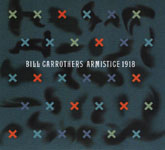
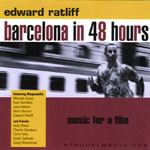
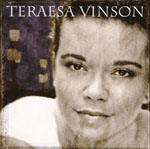




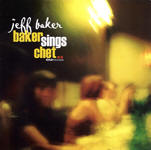
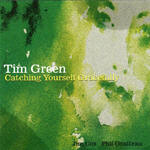
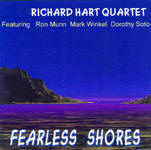
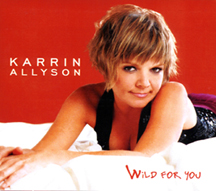
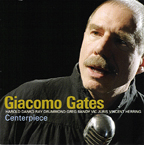
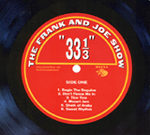






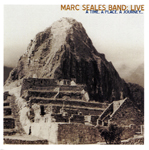 piano thumper, an OK rhythm ‘n’ blues stylist, and an average
blues shuffler, but when it comes to my current fave
genre—jazz—unfortunately, I’m just a hack with good ears, style
and panache.
piano thumper, an OK rhythm ‘n’ blues stylist, and an average
blues shuffler, but when it comes to my current fave
genre—jazz—unfortunately, I’m just a hack with good ears, style
and panache. 
